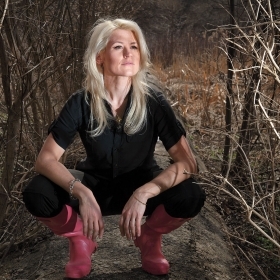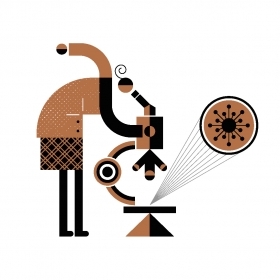Meagan Lizarazo ’04
When Meagan Lizarazo ’04 was a first-year at Wellesley, she used marshmallows and Twizzlers to construct “DNA” in her introductory biology class. Little did she know that the simple exercise foreshadowed a 15-year career at iGEM, a nonprofit that has shaped the field of synthetic biology.

When Meagan Lizarazo ’04 was a first-year at Wellesley, she used marshmallows and Twizzlers to construct “DNA” in her introductory biology class. Little did she know that the simple exercise foreshadowed a 15-year career at iGEM (International Genetically Engineered Machine), a synthetic biology nonprofit that, through its large international competition, has shaped the field of synthetic biology.
Synthetic biology is a tricky term to define. “You ask 10 different people what their definition is, and you’ll get 10 different answers,” Meagan says. For her, however, “it really comes down to using the power of biology to solve problems that we have in the world—and so that boils down to biology as technology.” A key element of synthetic biology? Building: “Synthetic biology is more like engineering, where the goal is to build something.”
So how did Meagan land at iGEM? It all started when, while on a lunch break from her job as a lab tech at Joslin Diabetes Center in Boston post-graduation, she bumped into the very same professor who had taught her introductory biology class at Wellesley, and had since moved to MIT. A phone call and several interviews later, and Lizarazo had joined a lab at MIT that was developing a system for synthetic biology research.
The system is based on standard biological parts—standardized chunks of DNA that encode for particular functions. “The idea was you should be able to just plug and play pieces of DNA, sort of like Legos—you can build anything with Legos because they all fit together,” she explains. “And then the idea was, let’s create a catalog of all of these biological parts, so that if you want a piece of DNA that does a particular thing, all you have to do is flip through a catalog of parts and find it.”
After completing the Registry of Standard Biological Parts in 2003, the lab invited a few teams of MIT undergraduates to use a starter kit of parts to design their own biological systems as a winter session course. Within a few years, the course had evolved into the iGEM competition, with teams from around the world, and in 2012, the iGEM Foundation was created. This past year, more than 300 teams competed, and Meagan estimates that more than 35,000 people have participated in the iGEM competition to date, including most working synthetic biologists.
Over the years, iGEM teams have engineered biological systems to solve a vast array of problems including detecting arsenic in wells in Bangladesh, disposing of avocado waste in Mexico, and testing for counterfeit honey in Indonesia. Often, teams use E. coli as the basis of their projects, engineering the bacteria to perform a specific function. Some of the projects have become biotech startups, such as Ginkgo Bioworks in Cambridge, Mass.
Meagan joined iGEM as a lab tech, eventually transitioning into an operations role where she was responsible for keeping the competition running smoothly. Now, as executive vice president and chief operating officer, she is taking on a new challenge: increasing iGEM’s visibility. She is also developing “After iGEM,” a network that connects the students who have competed. And, because around 80 percent of iGEM participants live outside the U.S., she is helping iGEM expand internationally, with its first overseas office planned for Europe.
As for what Meagan finds most compelling about synthetic biology, the answer is simple: “It just has so much potential. It’s like we’re in the early days of the internet, and we know that it’s going to have a huge impact on the world—we don’t know exactly how, and we don’t know exactly what, but there’s just so much potential, and you can feel it.”


